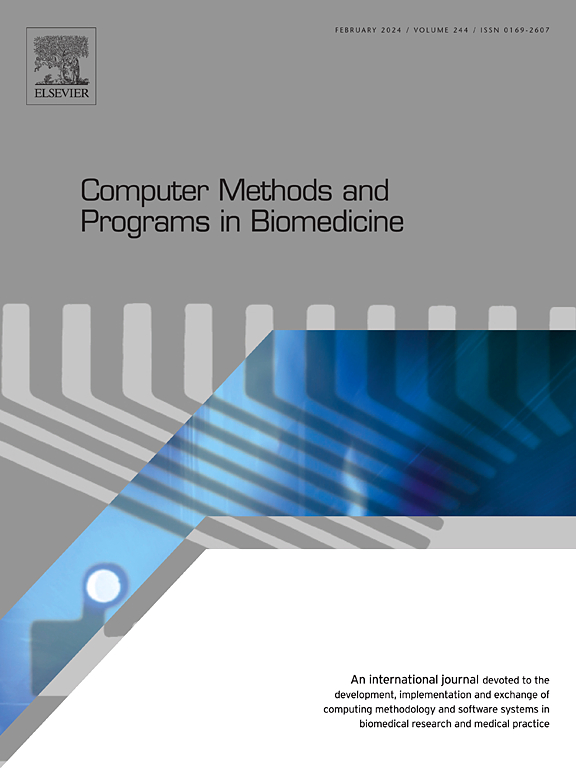High-resolution modeling of aqueous humor dynamics in the conventional outflow pathway of a normal human donor eye
IF 4.8
2区 医学
Q1 COMPUTER SCIENCE, INTERDISCIPLINARY APPLICATIONS
引用次数: 0
Abstract
Background and objective
The conventional aqueous outflow pathway, which includes the trabecular meshwork (TM), juxtacanalicular tissue (JCT), and inner wall endothelium of Schlemm's canal (SC) and its basement membrane, plays a significant role in regulating intraocular pressure (IOP) by controlling aqueous humor outflow resistance. Despite its significance, the biomechanical and hydrodynamic properties of this region remain inadequately understood. Fluid-structure interaction (FSI) and computational fluid dynamics (CFD) modeling using high-resolution microstructural images of the outflow pathway provides a comprehensive method to estimate these properties under varying conditions, offering valuable understandings beyond the capabilities of current imaging techniques.
Methods
In this study, we utilized high-resolution 3D serial block-face scanning electron microscopy (SBF-SEM) to image the TM/JCT/SC complex of a normal human donor eye perfusion-fixed at an IOP of 7 mm Hg. We developed a detailed 3D finite element (FE) model of the pathway using SBF-SEM images to simulate the biomechanical environment. The model included the TM/JCT/SC complex (structure) with interspersed aqueous humor (fluid). We employed a 3D, inverse FE algorithm to calculate the unloaded geometry of the TM/JCT/SC complex and utilized FSI to simulate the pressurization of the complex from 0 to 15 mm Hg.
Results
Our simulations revealed that the resultant velocity distribution in the aqueous humor across the TM/JCT/SC complex is heterogeneous. The JCT and its deepest regions, specifically the basement membrane of the inner wall of SC, exhibited a volumetric average velocity of ∼0.011 mm/s, which is higher than the TM regions, with a volumetric average velocity of ∼0.007 mm/s. Shear stress analysis indicated that the maximum shear stress, based on our FE code criteria, was 0.5 Pa starting from 10 µm into the TM from the anterior chamber and increased to 0.95 Pa in the JCT and its adjacent SC inner wall basement membrane. Also, the tensile stress and strain distributions showed significant variations, with the first principal stress reaching up to 57 Pa (compressive volumetric average) and the first principal strain reaching up to 3.5 % in areas of high mechanical loading. The resultant stresses, strains, and velocities exhibited relatively similar average values across the TM, JCT, and SC regions, primarily due to the uniform elastic moduli assigned to these components. Our computational fluid dynamics (CFD) analysis revealed that while the velocity of the aqueous humor remained consistent, the maximum shear stress was reduced by a factor of thirty.
Conclusion
The uneven distribution of shear stress and velocity within the TM/JCT/SC complex highlights the complex biomechanical environment that regulates aqueous humor outflow.
正常人供眼常规流出通道房水动力学的高分辨率建模。
背景与目的:包括小梁网(TM)、关节旁组织(JCT)、施勒姆管(SC)及其基底膜在内的常规水流出通道通过控制房水流出阻力在调节眼压(IOP)中发挥重要作用。尽管具有重要意义,但该区域的生物力学和流体力学性质仍未得到充分了解。流固耦合(FSI)和计算流体动力学(CFD)建模利用流出通道的高分辨率微结构图像,提供了一种在不同条件下估计这些特性的综合方法,提供了超越当前成像技术能力的有价值的理解。方法:在本研究中,我们利用高分辨率3D连续块面扫描电子显微镜(SBF-SEM)对正常人供眼灌注固定在IOP为7 mm Hg时的TM/JCT/SC复合物进行了成像,并利用SBF-SEM图像建立了详细的三维有限元(FE)模型来模拟生物力学环境。该模型包括TM/JCT/SC复合物(结构)和散布的房水(液体)。研究人员利用三维有限元算法计算了TM/JCT/SC复合物的卸载几何形状,并利用FSI模拟了复合物从0到15 mm hg的加压过程。结果表明:TM/JCT/SC复合物在房水中的最终速度分布是不均匀的。JCT及其最深处,特别是SC内壁基底膜的体积平均速度为~ 0.011 mm/s,高于TM区域,其体积平均速度为~ 0.007 mm/s。剪切应力分析表明,根据我们的有限元规范标准,从前房开始进入TM 10 μ m处的最大剪切应力为0.5 Pa,在JCT及其相邻的SC内壁基底膜处增加到0.95 Pa。拉伸应力和应变分布也表现出明显的变化,在高机械载荷区域,第一主应力达到57 Pa(压缩体积平均值),第一主应变达到3.5%。由此产生的应力、应变和速度在TM、JCT和SC区域表现出相对相似的平均值,主要是由于分配给这些组件的均匀弹性模量。我们的计算流体动力学(CFD)分析显示,当房水的流速保持一致时,最大剪切应力降低了30倍。结论:TM/JCT/SC复合物内剪切应力和速度分布不均匀,表明复杂的生物力学环境调控房水流出。
本文章由计算机程序翻译,如有差异,请以英文原文为准。
求助全文
约1分钟内获得全文
求助全文
来源期刊

Computer methods and programs in biomedicine
工程技术-工程:生物医学
CiteScore
12.30
自引率
6.60%
发文量
601
审稿时长
135 days
期刊介绍:
To encourage the development of formal computing methods, and their application in biomedical research and medical practice, by illustration of fundamental principles in biomedical informatics research; to stimulate basic research into application software design; to report the state of research of biomedical information processing projects; to report new computer methodologies applied in biomedical areas; the eventual distribution of demonstrable software to avoid duplication of effort; to provide a forum for discussion and improvement of existing software; to optimize contact between national organizations and regional user groups by promoting an international exchange of information on formal methods, standards and software in biomedicine.
Computer Methods and Programs in Biomedicine covers computing methodology and software systems derived from computing science for implementation in all aspects of biomedical research and medical practice. It is designed to serve: biochemists; biologists; geneticists; immunologists; neuroscientists; pharmacologists; toxicologists; clinicians; epidemiologists; psychiatrists; psychologists; cardiologists; chemists; (radio)physicists; computer scientists; programmers and systems analysts; biomedical, clinical, electrical and other engineers; teachers of medical informatics and users of educational software.
 求助内容:
求助内容: 应助结果提醒方式:
应助结果提醒方式:


